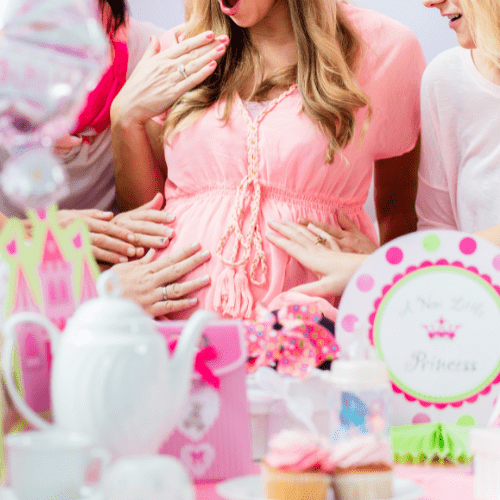Breastfeeding can be a personal choice for gestational parents. It is a process that requires changes to the body and can sometimes involve exposing your body in a public place.
Breastfeeding in and of itself is a natural and positive experience, but some people do experience harassment or are not comfortable for whatever reason breastfeeding in public or even at home. This is completely normal and fine.
Breastfeeding is a personal choice, and although some people are unable to feed their child by breast, it is also perfectly acceptable to opt out of breastfeeding altogether for your own reasons. Feeding your child comfortably and safely in the way that is best for you is always the best option.
If you are breastfeeding your child, you might find that it is difficult for many different reasons. Lactating can be tough on the body and providing a full amount of supply can be impeded by stress, fatigue, posture, medical conditions, diet and other factors. It may not be feasible to provide a wholesome supply always and using formula to supplement is always okay.
However, there are some options to help boost your supply to an extent and help make the factors around breastfeeding such as personal comfort, posture, electrolytes and more, easier to streamline for your breastfeeding journey. Do be wary of supplements that claim to unequivocally boost your feed, and always check out accredited sources online as to their efficacy.
Other parents can be a great resource, but anecdotal evidence can only describe personal experience and you should treat claims of unequivocal product success with skepticism. Have a look at Trust Pilot and the Better Business Bureau to examine whether products and businesses are what they say they are before you buy anything.
As an Amazon Associate, I earn from qualifying purchases. The links below may be affiliate links. Please read my disclosure policy for more information.
What are lactation aids?

Lactation aids can be more acute in their definition to refer to a specific medical device used by some parents-to-be. Some babies struggle to learn how to breastfeed, and they may not be accustomed to the breast; additionally, some parents prefer the contact of the baby to the breast for known skin-on-skin benefits for baby bonding and the health of the baby.
Lactation aids can assist in achieving both of these, while supplementing the breastmilk with previously expressed breastmilk or formula to ensure your baby stays healthy. Lactation aids can also refer to other nutritional supplements, or equipment, that assist a parent in the process of lactating and feeding their child via lactation. This can refer to breast pumps, artificial nipples, or other foods and items that are taken by parents to help supplement their flow.
What are lactation aids for supplementing breastfeeding?
Lactation aids are used for several purposes. The traditional medical lactation aid is a medical device that allows your child to be supplemented during feeding itself, with a variety of different substances that may help your baby gain weight.
These substances can range from enriched formula, previously expressed formula, physiological water instead of using a bottle or artificial nipple. Many doctors suggest that lactation aids are superior to feeding a baby with a syringe, bottle, cup feeding, or other methods. This is primarily considered to be because of the breast-to-baby feeding.
Using a lactation aid can be helpful if your baby is fussing at the breast, and you are struggling to get your baby to adjust to feeding at the breast. During a period of such struggling, it can be difficult and frightening to experience weight loss in your baby and it can be adverse for the health outcomes of the baby.
Lactation aids can be an assisting medical device during this learning period, or if your baby is not able to stay at the breast for long periods of time.
Why are lactation aids used?

The theory behind this medical device involves babies learning to breastfeed by being at the breast, without sacrificing their feed if they are not able to experience the let down reflex, obtain a good latch, or find enough milk at the breast as well. The use of a lactation aid can allow you to both adjust the baby to the breast, and learn how to breastfeed your baby at your breast.
Because lactation aids supplement the breastmilk, the breast is still being expressed during the use of a lactation aid that adds additional nutritional material. As a consequence, the encouragement of milk will continue and the supply of the breastfeeding parent should be continuous and should hopefully increase.
This is particularly helpful with regards to if the supply is reducing, as the continuous feed with supplemented material will stimulate the breast still ad should help to slowly increase the supply of the breastfeeding parents. The use of a lactation aid has the added benefit of improving supply naturally over time without compromising on the health of your baby.
This can be helpful with preventing your baby from becoming what is commonly termed in parenting circles as “bottle-spoilt”, “bottle-spoiled”, or “nipple-confused”. This term refers to the confusion that your baby may have regarding their instinct to root for the nipple when hungry or breastfeeding, and their ability to both latch onto the nipple and to stay latched for feeding.
Babies that use bottles frequently or particularly early on into child-rearing may have difficult latching to a breast at all and some babies may reject the breast altogether, starting and restarting feeding repeatedly, pushing at the breast and letting go after some time, and simply refusing or failing to feed in the initial circumstance. This is not the fault of the breastfeeding parent, and it can have a variety of causes.
Some babies may reject the breast because the flow is not sufficient for them and they find themselves both hungry and swallowing air. Other times the let down reflex may be too strong and babies find themselves having trouble swallowing as milk is flowing, due to an overflow of milk.
Bottles can often be easier for babies to control the flow of while feeding, whereas the breast can be variable both on time of day, whether you have expressed any milk earlier in the day, and simply your diet.
Other times babies may reject the breast because there is not a large enough supply in total of breastmilk.
Often babies will struggle to make a latch in the first place, particularly if they have used a bottle previously. It can be difficult for them due to the angle, and some babies do not have as strong a rooting reflex which can inhibit their ability to find the breast and initiate feeding in the first place.
Ceasing feeding however, if you are choosing to breastfeed, can cause further problems in that the lack of any breastfeeding can inhibit total supply.
Who might use a lactation aid?

Many people use a lactation aid. Some parents simply have a low supply of milk available in their breasts for feeding in the first place and do so out of requirement as well as a desire to breastfeed for emotional, physical or personal reasons.
However, many people also use lactation aids because they are attempting to improve the latch of their baby or help their baby gain more weight. Some conditions such as IGT, also known as Insufficient Glandular Tissue, cause people to not produce as much breastmilk as they might otherwise and may not have enough breastmilk naturally supplied to feed their children.
Some people may use a lactation aid to have a skin-to-skin bond with their baby if they cannot lactate, have had a mastectomy, or many other reasons as well.
Some people also adopt children, or have ceased lactation in the past. Lactation can be stimulated by allowing a baby to feed at the breast for some people, so many parents opt for this path with the goal of hopefully inducing lactation to provide some breastmilk for their child.
How does a lactation aid help?
A lactation aid is also known as an at-breast supplementer system in parts of the world. Although lactation aids can refer to alternative supplements, many of these are not medically verified and ineffective.
A lactation aid is a device that allows a parent to both feed their child, maintain and bolster their breastmilk supply, and keep the weight of their child high enough for healthiness.
The benefits of breastmilk are still felt with children that are fed partly with breastmilk to varying degrees, and many parents feel that even if they have to bolster their supply with formula or previously expressed milk, it is still rewarding and important for them to breastfeed.
A lactation aid is a device that allows this, by supplementing stimulation at the nipple which may induce lactation or promote it with an active but gentle stream of supplementary milk or formula.
Because the baby is less likely to reject the breast due to a lower flow, inconsistent flow or difficult feeding, the baby is more likely to stay at the breast for longer periods of time. Parents report less breastmilk to express after feeding, as the baby actually consumes it all even though this may be counter-intuitive.
It is this part of the process as well that is vital for boosting supply, as well as ease of feeding and the nutrition of the baby in general.
How do you use a lactation aid?

Although it may vary with regards to cleaning if you are using a system with a bottle or a bag, the steps aside from this are straight forward.
Milk, formula, or liquids deemed suitable by your doctor and/or healthcare professional should be placed in a clean bottle or bag.
If you are reusing your equipment, clean them with water and vinegar solution and hot, distilled water each day to ensure there is no build up and it is totally safe for the baby. Ensure that it is totally cool and clean before attaching for the baby’s use.
The strap is adjusted so that the bottle or bag is comfortably out of the way for feeding your baby. At this point, the baby should begin feeding at the breast as normal, and the provided tube should be positioned near the top of the mouth of the baby and at the end of your nipple.
Milk will be visible flowing through the tube, and milk should be gently warmed next to the human body and shouldn’t need to be warmed too heavily if it is refrigerated or cooled.
Ensuring the baby does not swallow the tube is paramount. To achieve this, a light amount of medical-safe tape should be used to affix the tube to the chest where comfortable and effective.
Medical tape is generally fairly cheap and affordable and can be affixed to the tube so that it is ready to attach whenever needed; it is also designed to be gentle on the skin for feedings.
Which are the best lactation aids?
Many people do opt to use a homemade system, but they can be difficult to use and materials must be vitally safe for young newborn children. Commercial systems can be limited, but there are two options that can be highly useful to those looking to induce lactation.
The Supplemental Nursing System is made by the brand Medela, and comes with a bottle that can be fitted with several sizes of tube to feed your child accordingly.
This is praised for both broad availability and the inexpensive build. The bottle is reportedly easy to clean, which is vital when feeding your baby.
Lact-Aid is another famous system that is lauded by parents. This brand does not come with a bottle, but bags to feed from with a tube that does not come in various sizes.
The Lact-Aid comes with a positioning strap for the milk bag, so that you can put it around your neck or shoulder when positioning the baby so it does not impede the process of feeding. The Lact-Aid system is somewhat more expensive, but is readily available around the United States.








